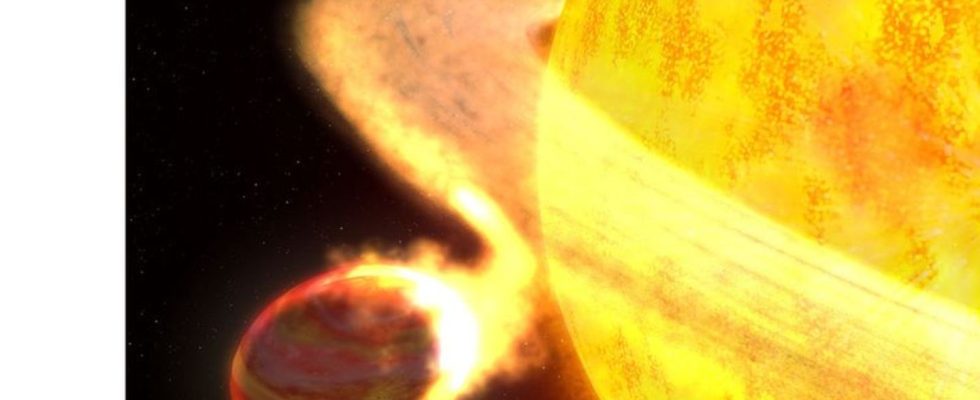Cosmic meal
Every twelfth star has already swallowed a planet
The illustration shows the exoplanet WASP-12b. It is the hottest known planet in the Milky Way Galaxy and possibly the shortest-lived. photo
© G. Bacon/Nasa, Esa (stsci)/dpa
Planets orbit their star – and sometimes they get too close. A research team has found out how often they are swallowed. It is not only young planetary systems that are the scene of such cosmic meals.
About every twelfth star already has at least one in its normal phase of life Planets devoured. This is what observations of 91 star twins by an international research team show: Despite being born together from a gas cloud, these pairs show striking differences in their chemical composition. These can only be explained by such a cosmic meal, the scientists report in the journal Nature.
Astronomers have already discovered signs of “pollution” from debris from planets or asteroids in many stars. In such cases, the atmosphere of the stars shows a clear enrichment with heavy elements, such as those found in rocky planets but not in normal stars. However, it was previously unclear how often stars devour one of their planets.
To find an answer to this question, Fan Liu from Monash University in Melbourne (Australia) and his colleagues searched for pairs of stars that formed from the same gas cloud. With the help of the European astronomy satellite “Gaia”, they were able to identify 91 pairs whose distance and their common movement through space indicate that they were born together – so they are star twins that must have originally had the same chemical composition.
Computer simulations
But as further, very precise observations with several large telescopes on Earth show, eight percent of these pairs show clear differences in the abundance of heavy elements in their atmospheres. Liu and his colleagues conclude that one of the two stars must have swallowed a planet not long ago.
Computer simulations of the formation of planets around young stars show that such catastrophes are not uncommon in the first hundred million years after the birth of a planetary system. “But such early events should no longer be detectable after several billion years,” emphasize Liu and his colleagues. Because the heavy elements sink into the interior of the star. However, the stars examined by the team are exclusively evolved stars similar to our Sun in their normal phase of life.
“We are probably seeing traces of later events,” the researchers continue, “triggered, for example, by disturbances from outside – such as another star passing nearby or a large gas planet entering the inner system.” Such disturbances can throw the orbits of the inner planets out of balance.
If one of the planets comes too close to its central star, it will be torn apart by its gravitational pull and its debris will fall onto the star. Such cosmic meals could be more common than previously thought, say the researchers, and therefore play an important role in the late evolution of planetary systems.

